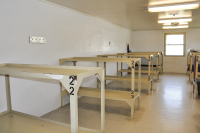Swain DSS ‘stretched thin’ prior to baby Aubrey’s death
Swain County social workers in charge of protecting children are paid less and handle more cases than those elsewhere in the state and region, factors that likely contribute to a higher-than-average turnover.
Swain’s Department of Social Services has been plagued by the loss of child welfare workers. It was chronically short staffed for much of last year — seven child welfare workers left over a nine-month period.
Each time one quit, the ones who remained had to pick up the pieces. Their work load increased. Cases were handed off midstream. The number of new hires in the ranks — lacking any formal training or education in the field — only made matters worse.
It was in this climate that the case of Aubrey Kina-Marie Littlejohn slipped through the cracks. Despite repeated warnings from relatives that baby Aubrey was being mistreated and neglected, social workers failed to intervene.
When Social Worker Craig Smith finally paid Aubrey’s caregiver a visit last September, the caregiver chalked up bruises on the baby to a fall down the stairs.
Smith told her to take the baby in for a physical exam. But the doctor’s exam never happened. Smith either forgot, or was too busy to follow up. And four months later, Aubrey died alone on a mattress on the floor in the back room of a single-wide trailer in a case that has sparked far-reaching outrage and sympathy.
Related Items
Smith has since admitted falsifying records to hide potential negligence and failures by the agency, according to law enforcement documents. He claims the orders to do so came from his superiors, and that knowledge of the cover-up went all the way to the top.
Swain DSS is under investigation by the State Bureau of Investigation. Its director has been fired and the majority of its board members replaced.
On the heels of the scandal, the state Department of Health and Human Services launched its own competency review of Swain DSS in March. The state audited a random sample of 57 child welfare cases to determine if Swain DSS was properly protecting children.
The state’s evaluation raised a red flag over the “significant turnover” in the past year.
“Turnover does have an adverse effect on the functioning of the agency. Turnover results in social workers being stretched thin to cover the workload of vacant positions,” according to the state review.
Furthermore, supervisors in charge of training new hires were not fully qualified to be in management roles, according to the report.
Smith, ironically, was not one of the many new hires at Swain DSS. He had been with the agency for four years.
But he was not untouched by the ripple effect of high turnover each time someone around him left.
“That person’s workload gets distributed among the survivors,” said Evelyn Williams, a clinical associate professor at the UNC School of Social Work.
Even once a replacement is found, the more experienced social workers often continue to shoulder a disproportionate case load, including the more difficult or complex cases — all the while trying to help the new workers learn the ropes.
The loss of a coworker can be more depressing than the sheer prospect of more work. Child welfare workers in a small agency can be tight knit and get depressed when they lose one of their own.
“It is really hard work to do. It is challenging work to do. It is emotional work to do,” Williams said. “Your coworkers become vital to your support system.”
Off the charts
Swain County’s extreme turn-over last year among child welfare workers is more than twice the average turnover in the state.
While worse off than other counties, Swain is hardly alone in its struggle. Statewide, 50 percent of child welfare workers quit within two years. Only 25 percent stick with it longer than five.
“It is not easy to keep and recruit qualified social workers,” said Bob Cochran, director of Jackson County DSS. “It is not an easy job. It can be very stressful.”
Swain DSS has been fighting abnormally high turnover for years.
The caseload carried by Swain’s child welfare workers, even when fully staffed, is higher than other counties.
But its lower salaries are most often blamed as the culprit, as the prospect of better pay in surrounding counties lured staff away.
“The agency has historically provided training to new staff who then move on to better paying jobs,” Swain DSS leaders asserted in 2009 in a “self-assessment” included in the state’s performance review that same year.
It’s a point few could argue.
“Poor counties have difficulty holding good workers,” agreed Ira Dove, director of Haywood County DSS.
But salary is not everything. Social workers who are fulfilled in their jobs are more likely to stick with it.
And that’s where smaller DSS agencies in rural counties should have an advantage.
“Smaller counties have this wonderful work environment to offer,” said Evelyn Williams, a clinical associate professor at the UNC School of Social Work. “The director probably knows your name, there are collegial relationships that are very close and supportive. The whole pace and climate is often different in a positive way that may offset to some extent the lower salaries.”
In rural counties, case workers have a stronger sense of community, which can also make the job more rewarding, according to Patrick Betancourt, Policy Program Administrator at the N.C. Division of Social Services.
“Even though it is a non-tangible thing, it does motivate the worker to strive for the best practices they possibly can,” Betancourt said.
It can not only make up for lower salaries, but larger case loads.
“They can tolerate the heavy work load when they feel like they are making a difference,” Williams said.
However, there is a tipping point.
“The higher the work load, the less able they are to be engaged in a way that might make a difference,” Williams said. And likewise, “if the salary is really low and people don’t feel like it is a fair salary, then it is a major problem that has to be solved before anything else kicks in.”
Why stretched so thin?
Swain County child welfare workers routinely work more cases than they should under state standards.
But how many social workers to hire — along with how much to pay them — is up to each county. The state and federal governments pitch in some money to cover social workers’ salaries, but counties pick up most of the tab and set their own salaries and staffing levels.
The state does, however, dictate a reasonable caseload — one that Swain routinely exceeded. Child welfare workers should have no more than 10 open cases at a time, according to state statute. Some Swain child welfare workers had nearly double that at times.
The state does not check for compliance to determine whether county DSS agencies are exceeding the maximum caseload for child welfare workers.
“Quite honestly, I believe that is a local responsibility,” said Sherry Bradsher, the state director of the Department of Health and Human Services.
Bradsher said it’s the job of the county DSS director “to make sure their agency is staffed appropriately.”
The state periodically does a performance review of each county DSS, about every three years or so. But caseload is not an area the state makes a habit of inspecting or asking about.
Bradsher said the state does keep monthly data on the number of child welfare cases in each county, and could feasibly calculate the caseload. But no one at the state level does so as a matter of course.
Besides, there are nuances behind the numbers.
“Just seeing we have 25 open cases doesn’t tell me a lot. How many are going to close in the next day or so? How many children are in each of those cases? How high risk are they?” Bradsher said. “It may be OK to be three or four cases over. I am not sure it is OK to have twice as many cases.”
If Bradsher learned that a county was routinely and egregiously exceeding the acceptable caseload, and she believed children’s safety was at risk as a result, it could trigger some heavy-handed intervention.
The state theoretically can seize control of child welfare functions, hire the necessary number of workers, and then bill the county for it, Bradsher said.
“We didn’t want situations where workers had too many cases,” Bradsher said of the state provision allowing for a take over. “Fortunately, we have never had to do that. Counties are very conscientious about the needs of child welfare. I think what you will find as far as positions across our state is most counties are appropriately staffed.”
However, an issue can arise when workers quit, Bradsher said.
“The problem comes in with vacancies. You have high turn over quite honestly, particularly in child welfare,” Bradsher said.
As the cases pile up, child welfare workers might be tempted to clear old cases from their books to make room for new ones. But it is unlikely child welfare workers would lower the bar to close cases more quickly and stay within the maximum caseload, according to Betancourt.
“I wouldn’t say there is pressure to let cases slide,” Betancourt said. “But you are constantly evaluating cases for safety and risk. As you start getting nearer your maximum you look at is there continued risk? You start evaluating more closely.”
Social workers could theoretically spend years working with a family.
“That’s part of what drives you to be a social worker. Can you make this family the best it can possibly be?” Betancourt said.
But at some point the social worker has to decide the improvement in the child’s home environment is adequate.
“That is constantly the balancing game that social workers have to play,” Betancourt said.
Oversight in the ranks
In addition to case load, the state also sets standards for supervisor-to-staff ratio: one supervisor for every five child welfare case workers.
Many counties exceed the supervisor to staff ratio by one or two workers, but won’t bite the bullet and hire that additional supervisor until they hit three or four over.
With a staff of experienced child welfare workers, pushing the ratio may be fine. When there are lots of new hires in ranks as there were in Swain, the ratio of one-to-five may not be enough.
Finding experienced, qualified supervisors is just as challenging as finding rank-and-file child welfare workers.
Often, those who excel in their job are promoted to supervisor, Betancourt said. But a good case worker doesn’t automatically make a good supervisor.
Promoting supervisors from within without giving them proper management training was a problem at Swain DSS, according to the state’s competency review of the agency in March.
Child welfare supervisors did not provide adequate direction, coaching and oversight for the rank-and-file child welfare workers, particularly given their lack of training and the large number of new hires.
Tammy Cagle, the former DSS director, had herself risen in the ranks. She started out as an entry level social worker in 1998 and within seven years had worked her way up to director. Cagle made $66,000 a year, on the very low end of DSS directors. The DSS director in Haywood makes $93,000 and in Jackson he makes $106,000.
Cagle had not asked the county to add additional child welfare positions for at least two years, according to the agency.
However, the new interim director, Jerry Smith, told county leaders he needed an additional child welfare supervisor as soon as possible.
“He needs the staff,” County Manager Kevin King told commissioners last week.
Swain County commissioners granted Smith’s request.
Quality supervisors, and enough of them, helps with the challenge of hiring and keeping good social workers, according to experts in the field.
“I think the supervisor to worker ratio is real key,” said Bob Cochran, the director of Jackson County DSS. “That really makes the difference to help people go over cases and debrief and train, especially new workers. They need a lot of face time and support and encouragement. That is real critical.”
Betancourt agreed.
“Having a supervisor that can help in making tough decisions and provide good clinical feedback is important,” Betancourt said.
Swain DSS was suffering from low morale among workers last year, according to the minutes of DSS board meetings.
In January 2010, board minutes referenced low morale among workers and team-building efforts to improve it. In December, one board member noted an improvement in morale, at least judging by the good time staff had at the agency’s annual Christmas luncheon, according to the minutes of the meeting.
Proof is in the training
The challenge developing good child welfare workers — both recruiting and retaining them — is the on-going subject of research by Williams at the UNC School of Social Work, considered one of the best in the field.
Williams held a round-table focus group with DSS directors from several WNC counties in Sylva this winter.
All said they suffered from a limited pool of qualified applicants.
“Directors have what is called a grow-your-own strategy in many places and that makes sense. People who already live in the community, have a commitment to the community and understand the community,” Williams said.
The problem, however, is that they lack training or education in child welfare or social work.
The job can be a “rude awakening” for those who have no training in the field, Cochran said. They won’t last long as a result.
The shortage of child welfare workers, particularly those trained in the field, spawned a state incentive program offering college scholarships to students willing to major in social work and put in requisite time on the job after graduation.
Similar to the state’s Teaching Fellows concept, the Child Welfare Education Collaborative offers $6,000 a year for undergraduates majoring in the field. In exchange, they must put in one year on the job for every year of financial assistance.
Western Carolina University was among the first universities to participate when it was started four years ago.
Cochran said it has helped with hiring prospects locally.
“For people who have majored in child welfare or social work, there is a cognitive resonance in what their dreams and aspirations are and what they are doing,” Cochran said. “They are really fulfilled and living their dream and tend to stay longer.”
But for the vast majority who don’t have the degree, on-the-job training becomes a make-or-break factor, Cochran said. It’s best to ease them in to the job, allowing them to shadow other workers at first, then making sure their first solo cases are easier ones.
“That is really key to longevity: the feeling of mastery early on. If they get overwhelmed early, you can bet they won’t be around long,” Cochran said.
Of course, it’s easier said than done when the rest of the staff is over-worked, and eager to have the new hire take on a full load as quickly as possible to relieve the burden.
“If you are low staffed and have had some turnover everyone else is carrying the load and suffering a bit,” Cochran said. While it’s tempting to have them hit the ground running, Cochran refrains in favor of what he considers a “long-term investment” that starts with good training.
The qualifications to be a child welfare worker aren’t particularly tough. It takes a four-year degree in a related field — and what qualifies as a related field is open to interpretation. A basic liberal-arts English degree counts as a related field as far as many counties are concerned. If counties are particularly desperate for workers, the list of “related” fields could be quite long.
“Like many other small counties, Swain County often has to under fill social work positions with persons who demonstrate some abilities, but do not necessarily have the experience and skill level commensurate with the requirements of the position,” according to the state’s competency review of the agency in the wake of the scandal.
All new hires must attend 72 hours of classroom training. The crash course is put on several times a year at a training site in Asheville where all western counties send their new hires.
After that, they are technically certified to start working cases. The training can’t come close to preparing child welfare workers from the things they will witness: children in drug infested homes, children being sexually abused by their own fathers, children going hungry.
“You can see quite a bit of burn out in a job like this,” said Betancourt.
Slipped through the cracks
Given the challenges recruiting and retaining child welfare workers, the lack of training for new hires, high caseloads in the face of turn over and generally stressful work, its not hard to understand how cases can fall through the cracks. But the consequences can clearly be tragic.
Smith was not the only social worker that witnessed Aubrey in a harmful environment.
In November of last year, social workers took an older child out of the same trailer where Aubrey lived, citing drug and alcohol use. Aubrey was left behind, however, despite social workers also witnessing extremely cold conditions in the trailer.
An autopsy report ruled hypothermia as a possible cause of death.
That same month, a third social worker made a yet another visit to the trailer, acting on yet another tip of abuse. Aubrey’s caregiver signed a statement promising not to physically punish Aubrey, who was only 13-months-old at the time. The autopsy report cited a previously broken arm and numerous recent bruises on her head.
Despite policies and procedures that are supposed to ensure the safety of children, there is not adequate oversight by the state when something goes wrong, said David Wijewickrama, a Waynesville attorney representing Aubrey’s family.
“The reason children contiunue to die in the state of North Carolina is because the state does not have on-site review that scrutinizes the actions of social workers and holds them personally accountable when it results in serious bodily injury of the death of a child,” Wijewickrama said.
Protecting children: by the numbers
Haywood DSS
Number of cases last year 1056
Child welfare supervisors 3.5
Child welfare workers 18
Starting salary $37,500
Turn-over 4 last year; on par with previous years
Jackson DSS
Number of cases last year 666
Child welfare supervisors 2
Child welfare workers 11
Starting salary $39,800
Turn-over 4 last year; higher than average
Swain DSS
Number of cases last year 528
Child welfare supervisors 2; soon to be 3
Child welfare workers 8
Starting salary $33,000
Turn-over 7 last year













